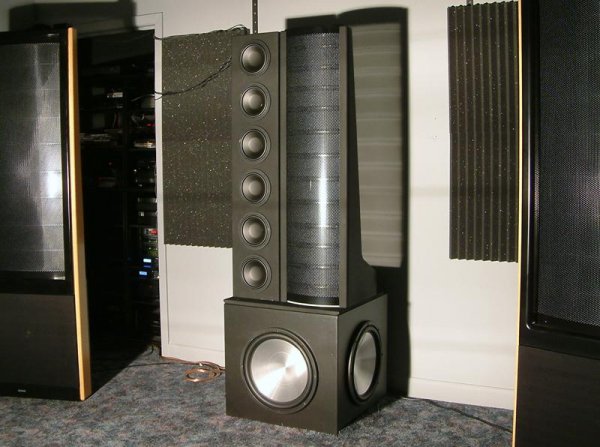Ever have that sense that something is not quite right with your setup, and you know there just has to be something that will do the job a bit better out there?
Well, that's how I felt back in 2006 about the MartinLogan Logos center channel I had paired with my all ML setup with Monolith III fronts and Sequel II rears.
I looked around, thought a lot about the problem, especially given the fact that the center carries 80% of dialog and sound in most modern movies, and decided that I needed a high-performance center that could match my Monoliths.
So I set out to design and build such a beast. The entire journey is detailed in the associated build thread on the MartinLogan Owners forum.
Now that I've had it in use for six years, I can say it has been an incredible success, there has not been a mutlichannel disc or movie soundtrack that has phased this thing. It just rocks out and is crystal clear.
IMHO none of the factory designs come even close to delivering a great MCH experience, this is what it takes to truly achieve a seamless soundstage.
And, here is a picture of it with the acoustically transparent screen removed (and no acoustic treatments applied yet):

Well, that's how I felt back in 2006 about the MartinLogan Logos center channel I had paired with my all ML setup with Monolith III fronts and Sequel II rears.
I looked around, thought a lot about the problem, especially given the fact that the center carries 80% of dialog and sound in most modern movies, and decided that I needed a high-performance center that could match my Monoliths.
So I set out to design and build such a beast. The entire journey is detailed in the associated build thread on the MartinLogan Owners forum.
Now that I've had it in use for six years, I can say it has been an incredible success, there has not been a mutlichannel disc or movie soundtrack that has phased this thing. It just rocks out and is crystal clear.
IMHO none of the factory designs come even close to delivering a great MCH experience, this is what it takes to truly achieve a seamless soundstage.
And, here is a picture of it with the acoustically transparent screen removed (and no acoustic treatments applied yet):

Last edited:

